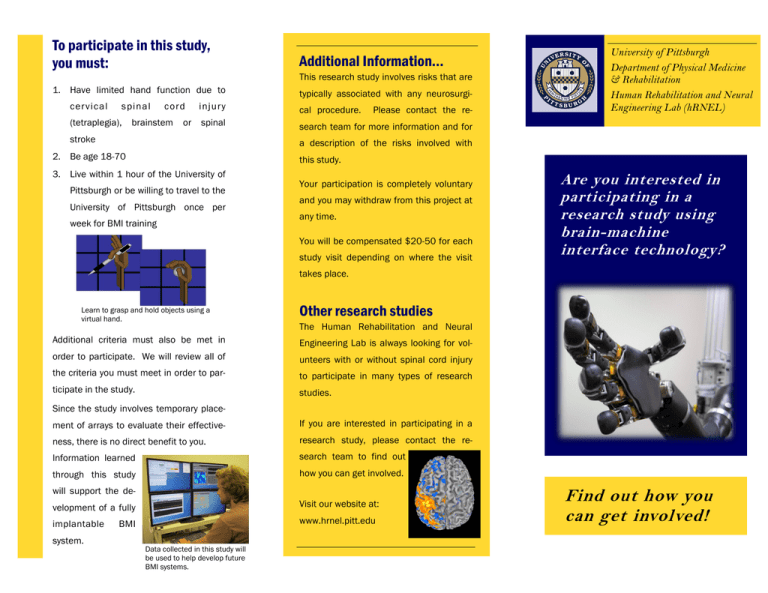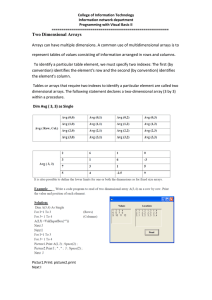To participate in this study, Additional Information... you must: University of Pittsburgh
advertisement

To participate in this study, you must: Additional Information... This research study involves risks that are 1. Have limited hand function due to cervical s pinal (tetraplegia), cord brainstem or typically associated with any neurosurgi- injury cal procedure. spinal search team for more information and for stroke Please contact the re- University of Pittsburgh Department of Physical Medicine & Rehabilitation Human Rehabilitation and Neural Engineering Lab (hRNEL) a description of the risks involved with 2. Be age 18-70 this study. 3. Live within 1 hour of the University of Pittsburgh or be willing to travel to the University of Pittsburgh once per week for BMI training Your participation is completely voluntary and you may withdraw from this project at any time. You will be compensated $20-50 for each study visit depending on where the visit Are you interested in participating in a research study using brain-machine interface technology? takes place. Learn to grasp and hold objects using a virtual hand. Other research studies The Human Rehabilitation and Neural Additional criteria must also be met in Engineering Lab is always looking for vol- order to participate. We will review all of unteers with or without spinal cord injury the criteria you must meet in order to par- to participate in many types of research ticipate in the study. studies. Since the study involves temporary placement of arrays to evaluate their effective- If you are interested in participating in a ness, there is no direct benefit to you. research study, please contact the re- Information learned search team to find out through this study how you can get involved. will support the development of a fully Visit our website at: implantable www.hrnel.pitt.edu system. BMI Data collected in this study will be used to help develop future BMI systems. Find out how you can get involved! Brain-Machine Interface Research The Human Rehabilitation and Neural Engineering Laboratory (hRNEL) is conducting a study to investigate the use of NeuroPort Arrays for brain-machine The goal of the study is to demonstrate the While the arrays are implanted, our research safety and efficacy of using two arrays for long- team will conduct BMI training sessions up 5 term recording of brain activity, which will be days per week. However, we will work with used to control computer cursors and assistive you to determine the testing schedule. technologies that help people complete activities of daily living. interface (BMI) technology. BMI tech- Study Procedures nology is based on the finding that with We have received approval from the FDA to intact brain function, neural signals are conduct a research study to implant the arrays generated even though they are not for approximately 1 year under an Investiga- sent to the arms, hands and legs. tional Device Exemption (IDE). As part of this study, you will undergo two surgical procedures approximately one year apart to implant and remove two arrays. Tasks include computer displays and virtual reality environments The goal of training is for you to learn to use your brain activity to control computer cursors, videos games, or assistive technology. This will take practice and we will start with simple computer tasks. Testing may occur at your home or in our research laboratory. You will learn to move a specially designed robotic arm using your brain activity After approximately 1 year, the arrays will be removed. You will likely stay in the hospital for Two small electrode arrays will be implanted in the area of the brain that You will work with doctors, therapists and engineers throughout the study. controls your movements. With training you can learn to use your neural Two small arrays about the size of pencil erasers signals to will be implanted through a flap in your skull control a approximately 5x5 cm in size. The wires from variety of the arrays will be attached to a connector that is devices or fixed to the skull where it can be connected to computer our computer system. You will likely spend up to displays. 2 weeks in the hospital for post-surgical moniParticipants will learn to control virtual environments. toring. about 1 week after surgery. You will also be asked to return for follow-up visits to monitor your recovery. The total duration of the study will be up to 25 months. University of Pittsburgh Dept. of Physical Medicine & Rehabilitation Human Rehabilitation and Neural Engineering Lab (hRNEL) If you may be interested in participating, please contact Debbie Harrington, research coordinator Phone: 412-383-1355 Email: harringtond2@upmc.edu


